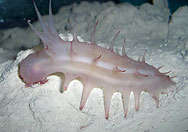

 | |||||||||||||||||||
|
|
Journals 2008/2009Roy Arezzo
July 19, 2008 As we wrapped up Station F in light snow there are a few things I have been hearing often. One, science work is going well and we are on schedule. Secondly, it is coming close to that time when we will leave the protection of the ice; the expectation is that by this time tomorrow we will be far enough north to be back to open sea meaning more ship rolling which potentially can make it more difficult to take samples. Not to say that all goes well in calm seas. The Box Core hit a rock today and came up dry with a bent plate. The Tucker trawl also malfunctioned. It has multiple nets used to sample plankton that can be opened at different depths by a metal messenger sent down the cable from the ship. These did not work so we spent some of today hoisting up our equipment, tweaking and sending it back down. When we were deploying the Box Core the second time we were visited by a large seal off the stern. Someone mentioned it was probably a leopard seal, which can be a very aggressive animal and feed on smaller seals and penguins. This particular animal seemed nice enough as it swam around the pool of free water we broke through for a couple of minutes to check us out. Presumably a Box Core is less interesting to a seal than a fishing net, so it did not stick around long enough for me to grab a camera. The night went smoothly after that and I did not think I had much to write about until Paulo came into the dry lab with his camera and much of night crew joined us to watch some footage of our aquarium critters feeding. The tank I had set up yesterday had been filled with fresh sediment and some animals that came up in the Box Core. The Box Core is not necessarily designed to collect animals but when it does capture them in the sediment the animals arrive in better shape than a trip through a trawl net. With all the sampling we do for nutrient flow we are interested in who is using the nutrients and how they assimilate and redistribute them in their waste. The sea pig, a type of sea cucumber has interesting mouth parts and not many folks have witnessed its feeding since it is essentially a deep sea animal. There was speculation that many of the animals were dormant in the more southern latitudes during winter, however, we have data that shows most of the animals feed year round. With all the fancy equipment we have sent down for imaging I was surprised to see the most sophisticated recording we could get up here at sea level was Paulo on his belly in the aquarium room with a digital camera. Regardless of the methods, we obtained some interesting footage of our resident echinoderms feeding on mud.
Echinoderms are a group of invertebrates that are typically taught in high school biology as the phylum of invertebrates with spiny skin; of course, it is not that simple. We have seen a diverse mixture of echinoderms on this cruise. We have pulled up sea stars, urchins, sea cucumbers, brittle stars and sea lilies, all different classes of echinoderms that vary in how they feed. Sea stars are essentially predators eating clams and soft-bodied animals where as sea lilies look more like sponges and tend to be filter feeders. The sea cucumbers are mostly epibentic deposit feeders, in that they live on the surface of the seafloor ingesting sediment and digesting the organic material from the top layers. Of the deposit feeders in Antarctica, Protelpidia murrayi (sea pigs) and Peniagone vignioni (no common name, Peniagone for short) are uncharacteristic in many ways. They are mostly comprised of water, a thin see-through skin and a digestive tract. Sea pigs tend to move slowly along the bottom grazing on mud as they go. The Peniagone can swim and move faster than the sea pig and consequently may be more selective in the quality of food. The Peniagone in our tank repeatedly used its mouth appendages to take mud sample to different parts of its head, which we postulate may be a way of chemically tasting the food for nutritional quality.
|
||||||||||||||||||



